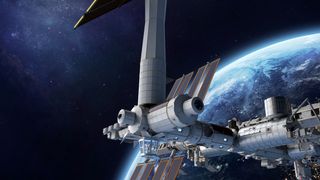
Even as commercial spaceflight company Axiom Space prepares to launch the first fully private crew to the International Space Station early next year, its engineers are also developing in-house spacesuits.
Texas-based Axiom teased the spacesuits in a tweet posted on Nov. 23. While the suits fit into Axiom's own long-term plans of creating private space stations that can host paid research missions, the company also hopes to provide the suits to NASA as the space agency prepares for crewed Artemis program launches to the moon.
"In many ways, the spacesuit is just like a space station," Matt Ondler, Axiom's chief technical officer, told Space.com. "It has all the same systems and all the same things you worry about."
Related: The evolution of the spacesuit in pictures
Axiom Space was founded in 2016 by a former NASA manager. In its first mission, a crew of three private civilians commanded by retired NASA astronaut Michael López-Alegría will fly to the International Space Station in February 2022. The quartet will launch on a SpaceX Falcon 9 rocket tucked inside a Crew Dragon capsule to spend about a week on the orbiting laboratory. Each passenger is reported to have paid $55 million for the experience.
In addition to enjoying the view, the crew will be conducting a number of research experiments. Alongside the existing contingent aboard the ISS, Axiom-1's passengers will conduct around 100 hours' worth of research, including a holographic image demonstration and several studies on the effects of space travel on the human body.
This mission is coming far too soon to feature the suits, which are part of Axiom's longer-term plans. Over the next several years, Axiom will be launching modules that will attach to the space station's Harmony module; the company plans to detach its modules to establish free-flying space stations before the ISS retires. Axiom plans to have an airlock in orbit by 2027 to support spacewalks, also known as extravehicular activities or EVAs.
Get the Space.com Newsletter
Breaking space news, the latest updates on rocket launches, skywatching events and more!
New missions.New suit.New provider. pic.twitter.com/laAZuH9XADNovember 23, 2021
So, the spacesuits fit well into these plans. They will let astronauts go out and repair modules from space. In addition, Axiom hopes the spacesuits will make it easier for astronauts to build infrastructure in space, without the cumbersome need to launch modules from the ground, Ondler told Space.com.
In-house spacesuits may also attract more passengers, of course. "We discovered that a lot of our private astronaut customers would like to experience an EVA," Ondler told Space.com. "So we're trying to figure out ways to make that very safe and easy to do."
The company has recruited personnel from NASA or NASA contractors for the job. Ondler didn't comment on the cost of the spacesuit project, but he did tell Space.com that, "in general, we think that we can build a suit in-house very cost-effectively."
Although Axiom wouldn't use the new spacesuits 2027, Axiom hopes to have the spacesuits ready by 2024. That's because NASA is now looking to procure new suits for EVAs in Earth orbit, in addition to Artemis moonwalks and spacewalks from the Gateway outpost meant to orbit the moon. NASA has said it will start awarding contracts in 2022, and Axiom hopes to be in the discussions.
"Having that capability in 2024 allows us to also partner with NASA and potentially be a suit provider for NASA," Ondler told Space.com.
Follow us on Twitter @Spacedotcom and on Facebook.
Join our Space Forums to keep talking space on the latest missions, night sky and more! And if you have a news tip, correction or comment, let us know at: community@space.com.

Rahul Rao is a graduate of New York University's SHERP and a freelance science writer, regularly covering physics, space, and infrastructure. His work has appeared in Gizmodo, Popular Science, Inverse, IEEE Spectrum, and Continuum. He enjoys riding trains for fun, and he has seen every surviving episode of Doctor Who. He holds a masters degree in science writing from New York University's Science, Health and Environmental Reporting Program (SHERP) and earned a bachelors degree from Vanderbilt University, where he studied English and physics.